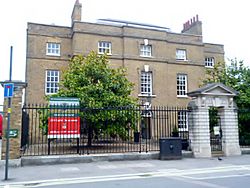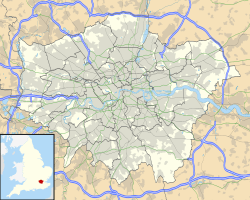Fulham House facts for kids
Quick facts for kids Fulham House |
|
|---|---|
| Fulham, London | |

Fulham House
|
|
|
Location within London
|
|
| Coordinates | 51°28′05″N 0°12′37″W / 51.46799°N 0.21021°W |
| Type | Drill Hall |
| Site history | |
| Built | 1902 |
| Built for | War Office |
| In use | 1902-Present |
Fulham House is a special building in Fulham, London. It is located at 87 Fulham High Street. This building is considered a important historical site. It is officially known as a listed building (Grade II). This means it has special historical or architectural importance.
Contents
The Long History of Fulham House
Fulham House has a very interesting past. It has been many things over the years. Let's explore how this building changed.
From Ferrymen to Famous Merchants
The very first house on this spot was called Passors. This name came from a family who lived there a long time ago. They were ferrymen during the time of King Edward III. A ferryman helped people cross a river.
Later, a rich wool merchant named Ralph Warren lived here. He was even the Lord Mayor of London in 1536. The Lord Mayor is like the main leader of the city. After him, another important cloth merchant, Sir Thomas White, owned the house. He was also a Lord Mayor. Sir Thomas White was known for helping his community. He even started St John's College, Oxford.
The house was then passed down to Sir Henry Cromwell. He was the grandfather of Oliver Cromwell. Oliver Cromwell became a very famous leader in English history.
A New House and a Girls' School
The building you see today was built in the early 1700s. It started as a private home. In 1804, it became a school for girls. It was called the Fulham House School for Girls. Different families ran the school over many years. The Misses King ran it for 40 years, starting in 1840.
In 1879, a local builder named Parkins Hammond Jones bought the house. His family lived there until 1902. That's when something new happened to Fulham House.
Becoming a Military Base
In 1902, the house was bought by a military officer. It became the headquarters for his unit. This unit was the 26th Middlesex (Cyclist) Rifle Volunteer Corps. They were soldiers who used bicycles!
World War I and Changes
This bicycle unit later became the 25th (County of London) Cyclist Battalion in 1908. When World War I started in August 1914, the battalion got ready at Fulham House. They were then sent to fight on the Western Front. This was a major battle area in France and Belgium.
In 1937, the battalion changed again. It became part of the 47th (2nd London) Divisional Signals. This was part of the Royal Signals. The Royal Signals are experts in military communication.
After World War II
After World War II, Fulham House continued as a military base. It became the main office for the 23rd (Southern) Corps Signal Regiment. Later, in 1967, a different unit moved in. This was B (Queen's Royal Rifles) Company of the 4th Battalion the Royal Green Jackets.
This unit changed its name in 1999. It became F (Royal Green Jackets) Company, The London Regiment. However, F Company was later disbanded in 2004.
Today's Use
In 2006, Fulham House got new occupants. The main headquarters of the Royal Yeomanry moved in. This is a special part of the British Army. Also, their command and support squadron, the Westminster Dragoons, moved there.
As of 2014, Fulham House still serves the military. Its drill hall holds a special memorial. This memorial remembers soldiers from the London Scottish regiment who died in the world wars.


